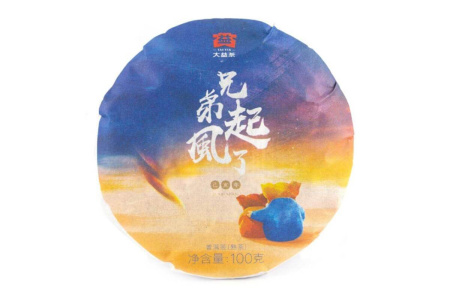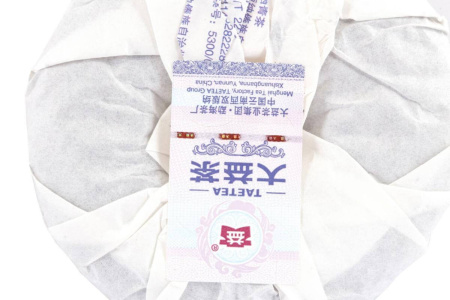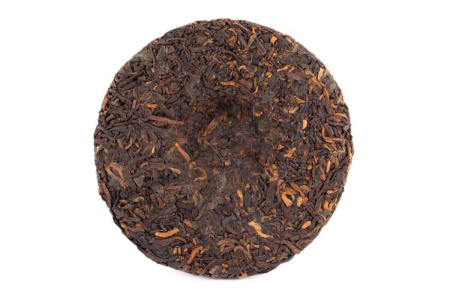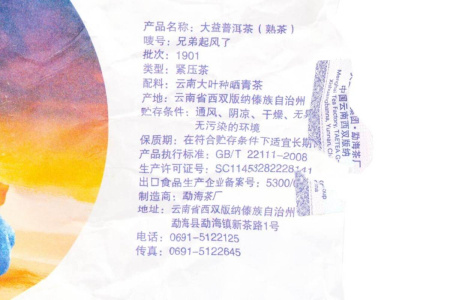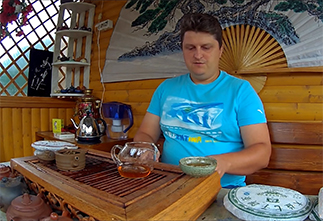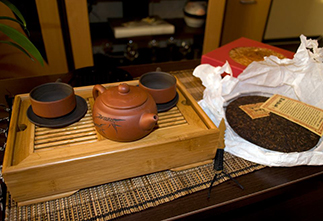-
0 Saturation
-
0 Aftertaste
-
0 Aroma
-
0 Effect
-
0 Balance
-
0 Body
Шу Пуэр 2018 г. «Братья, поднялся ветер»: шедевр от Мэнхая
Шу Пуэр 2018 г. «Братья, поднялся ветер» от знаменитой чайной фабрики Мэнхай – это настоящий подарок для ценителей пуэра. Этот чай, выдержанный в течение нескольких лет, приобрел глубокий, насыщенный вкус и богатый аромат, которые оценят даже самые требовательные гурманы.
История создания и особенности
Чайная фабрика Мэнхай славится своими высококачественными пуэрами, которые производятся по традиционным технологиям. Шу Пуэр «Братья, поднялся ветер» не стал исключением. Для его создания использовалось сырье высочайшего качества, собранное в лучших чайных садах Юньнани. Тщательная ферментация в кучах позволила получить чай с ярким, насыщенным вкусом и многогранным ароматом.
- Производитель: Мэнхай – один из старейших и наиболее уважаемых чайных заводов Китая.
- Название: «Братья, поднялся ветер» – поэтическое название, отражающее характер этого чая: энергичный, яркий, с нотками свежести.
- Сырье: Высококачественные чайные листья, собранные в 2018 году.
- Ферментация: Традиционная ферментация в кучах.
- Прессовка: Блин весом 100 грамм.
Вкус и аромат
В сухом виде чай обладает бархатистым ароматом с древесно-сливочными нотками, нюансами свежих орехов и горького шоколада. После промывки аромат становится более насыщенным, с оттенками распаренной древесины, халвы с орешками и сухофруктов.
Вкус заваренного пуэра классический, яркий и хорошо сбалансированный. Ощущается домашний бисквит, пастила с орехами и освежающая нотка вишневого сока. Тело чая густое, обволакивающее, настой маслянистый. По мере увеличения проливов появляется приятная горчинка, приносящая с собой яркие штрихи грецкого ореха. Шу пуэр выдерживает 7 полноценных проливов, оставляя объемное, долгоиграющее послевкусие с орехово-шоколадными нюансами.
Полезные свойства
Как и другие виды пуэра, Шу Пуэр «Братья, поднялся ветер» обладает рядом полезных свойств:
- Улучшение пищеварения: Способствует нормализации пищеварения и обмена веществ.
- Тонизирование организма: Повышает жизненный тонус и бодрость.
- Антиоксидантные свойства: Защищает клетки организма от вредного воздействия свободных радикалов.
- Благотворное влияние на сердечно-сосудистую систему: Помогает снизить уровень холестерина и улучшить кровообращение.
Как заваривать
Для заваривания этого пуэра рекомендуется использовать чайник из исинской глины или фарфоровую гайвань объемом 150-200 мл. Температура воды должна быть около 95°С. На одно заваривание достаточно 7-10 граммов сухого чайного листа.
Почему стоит попробовать этот пуэр?
- Высокое качество: Произведен на знаменитой чайной фабрике Мэнхай.
- Уникальный вкус: Глубокий, насыщенный вкус с многогранным ароматом.
- Полезные свойства: Благотворно влияет на организм в целом.
- Потенциал для хранения: Шу пуэры с возрастом становятся только лучше, поэтому этот чай может стать отличным инвестицией.
Шу Пуэр 2018 г. «Братья, поднялся ветер» – это настоящий шедевр чайного искусства, достойный самых взыскательных ценителей. Его изысканный вкус и тонкий аромат перенесут вас в мир китайских чайных традиций.
When dry, the tea's aroma is velvety and soft, with woody, creamy notes and hints of fresh nuts and dark chocolate. After washing, the aroma of pu-erh is dense, warm, and rich. It reveals steamed wood, halva with nuts, and hints of dried fruit.
The flavor of brewed pu-erh is classic, vibrant, and well-balanced. It features homemade biscuit, nutty pastilles, and a refreshing hint of cherry juice. The tea's body is thick and enveloping, the infusion oily, and very easy to drink. As you steep it longer, a pleasant bitterness emerges, bringing with it vibrant hints of walnut.
The 2019 Shu Pu'er "Brothers, the Wind Has Risen" is brewed for seven full steeps, leaving a rich, lingering aftertaste with nutty and chocolate nuances. For brewing, use a Yixing clay teapot or porcelain gaiwan with a capacity of 150-200 ml, using 7-10 g of dry tea leaves.
The color of the finished infusion is dark chestnut, with a rich dark burgundy hue.
This pu-erh tea is a great tonic, invigorating, and sociable tea. It warms and relaxes the body, improves mood, and inspires.
The 2019 "Brothers, the Wind Has Risen" Shu Pu'er from the Dai brand at the Menghai Tea Factory makes a wonderful gift for a tea lover. This high-quality tea from a renowned tea factory offers a pleasant, classic flavor and a powerful therapeutic effect.
|
Name in Chinese
|
兄弟起风了 |
|
Pinyin
|
xiōng dì qǐ fēng le |
|
English name
|
Brothers, the wind has risen |
|
Translation
|
Brothers, the wind has risen |
|
Country
|
China |
|
District
|
Xishuangbanna Dai Autonomous Prefecture |
|
Provinces
|
Yunnan (云南) |
|
Region
|
Menghai (勐海) |
|
Manufacturer
|
Мэнхай (勐海) |
|
Raw material production date
|
2018 |
|
Year of pressing
|
2018 |
|
Pressing form
|
Fang Cha (Square Tea) |
|
Declared weight, g
|
100 |
|
Tea tree (bush) variety
|
Da Ye Zhong |
|
Fermentation method
|
In heaps |
|
Length, cm
|
11 |
|
Width, cm
|
11 |
- Reviews
- Vkontakte
Pu-erh is one of the most unique types of tea, which only gets better with age. Many people, when they first encounter this tea, wondered: why is pu-erh more often found in pressed form (cakes, bricks, tochas), and not in loose form? The reasons for this are related to both history and the practical aspects of storing and fermenting tea. Despite modern technologies that allow the production of loose pu-erh, the shape of pressed cakes remains unchanged. And pu-erh is more often found on sale in pressed form, for example, in the form of cakes or bricks, and loose pu-erh is less common. We will talk about the reasons for pressing pu-erh into cakes in this article.
Puer is a unique Chinese tea that is distinguished by its depth of taste, complexity of aromas and versatility of aftertaste. Its taste characteristics are formed under the influence of many factors, from growing conditions to the brewing method. Let's look at the main ones.
Menghai (Chinese: 勐海 茶厂, pinyin: měnghăi cháchăng, official website of the plant: http://www.dayitea.com ) is one of the oldest and most respected tea brands in China. Menghai Tea Factory produces more than 750 tons of tea of more than 120 types per year. The plant owns 220,000 acres of tea plantations, it is the second largest plant in the province, the number of people working there exceeds 800 people. 48 products of the plant have been awarded at various times by the provincial and national governments.
The question often arises: how to brew puerh correctly? Sometimes the phrase "to get high" is added to it. Moreover, everyone has their own understanding of this phrase. Some mean vigor, and some - intoxication. So how to brew puerh tea correctly? Let's consider several options.
Traveling through the tea mountains, we found ourselves in another land of blue roofs - the village of Zhongcai, which is located in the Menghai district of Yunnan province. According to tradition, we were shown another local tea tree, which, according to the Chinese, is at least a million years old :) The village is very authentic, not designed for tourists, there are many wild pu-erhs there and, of course, we were warmly received. They treated us to local cuisine and tea. We also asked the residents about the prices of tea and how they have changed in recent years.
The tea ceremony occupies a special place in the centuries-old Eastern tradition. And although the essence of this phenomenon remains constant, the nature and external manifestations of the tea ceremony in different nations have their own national characteristics. In each Chinese province, the tea ceremony and the tea used in it are varied: for example, residents of the southern provinces prefer green tea, and residents of the northern provinces - red tea, in Fujian province they more often use Oolong tea, and in Yunnan province Puer tea is widely known.








